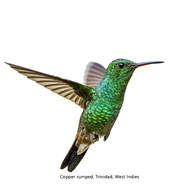|
The copper-rumped hummingbird (Amazilia tobaci) is a small bird that breeds in Venezuela, Trinidad and Tobago. It is the predominant species of hummingbird in Trinidad and Tobago.
This hummingbird inhabits open country, gardens and cultivation. The female copper-rumped hummingbird lays its eggs in a tiny cup nest on a low branch, or sometimes wires or clotheslines. Incubation takes 16–17 days, and fledging another 19-23, and there may be up to three broods in a season. The copper-rumped hummingbird is 8.6 cm long and weighs 4.7 g. The bill is fairly long, straight and mostly black with some pink on the lower mandible. The adult has copper-green upperparts, becoming copper-bronze on the rump. The head and underparts are bright green, the thighs are white and the tail and legs are black. The sexes are similar. The food of this hummingbird is nectar, taken from a wide variety of flowers, and some small insects. Copper-rumped hummingbirds perch conspicuously and defend their territories aggressively against other hummingbirds, bees, and larger bird species; this is especially during mating season, which is early in the year. The call of this species is a chip, and the song is a high-pitched tyee-tyee-tyoo. Copper-rumped hummingbird photographed by Rachel Lee Young in the RAPSO garden, Diego Martin
1 Comment
|
AuthorRachel Lee Young. Photographer Archives
January 2020
Categories |


 RSS Feed
RSS Feed
